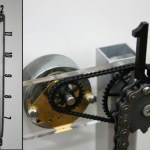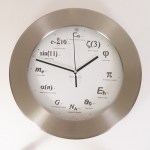Clocks
So BoingBoing has an item on hanging chain clocks, on sale from Ticktock Showroom at a bargain $100. I wrote about a similar art piece by Andreas Dober a year ago on these very pages, but that had a price tag of $2,338, so I'm glad to see bicycle chains have come down in price.
Here's the thing though: to my eyes, both this clock and the original by Dober are backwards. The clock is designed so that the chain takes the place of the hands as the moveable part, and thus someone decided that it should go clockwise. As a result, the numbers are printed in the opposite order to a usual clock.…
I have to admit, I'm writing this one up partly because it lets me use the title reference. It's a cool little paper, though, demonstrating the lengths that physicists will go to in pursuit of precision measurements.
I'm just going to pretend I didn't see that dorky post title, and ask what this is about. Well, it's about the trapping and laser cooling of thorium ions. They managed to load thorium ions into an ion trap, and use lasers to lower their temperature into the millikelvin range. At such low temperatures, the ions in the trap "crystallize."
So, they've demonstrated that if you get…
Sometimes you wake up and you think of a really good idea and then after a couple of hours trying to find out how QR patterns are encoded you remember to Google your idea and find someone's already done it.
But I don't mind. Check out this sweet QR code clock by QR Planet.
In case you're wondering, a QR code is simply a two-dimensional barcode. It's a way of packing a lot of machine-readable data into a small space. QR patterns can encode URLs, text, phone numbers, and contact details. You can scan them with your cameraphone if you have the right software - there's plenty of free…
Yesterday's post on a variation of the "Twin Paradox" with both twins accelerating was very successful-- 337 people voted in the first poll question, as of a little before 9am, and the comments to the original post are full of lively discussion. That's awesome.
I wish I could take credit for it, but the problem posed is not original to me. It comes from a 1989 paper in the American Journal of Physics, which also includes the following illustration setting up the situation:
The article contains a full explanation, and also the following figure illustrating the result:
The correct answer is…

